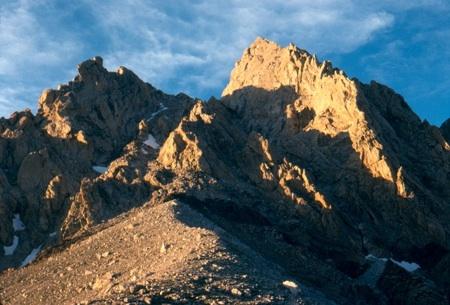Climbing the Grand Teton in Grand Teton National Park never is easy. Snow conditions can create problems, being exposed is daunting for some, and for others just the impact of climbing above 12,000 feet can be a problem if they're not properly acclimated.
Weather conditions are a wild card, and this week 17 climbers encountered that issue, one fatally.
On Thursday, a day after lightning bolts rained down on the 13,744-foot peak, the body of Brandon Oldenkamp, a 21-year-old from Sanborn, Iowa, who was climbing with six others when the storm hit Wednesday, was spotted and recovered.
How there were not more fatalities is a wonder. As the thunderstorm swept across the crag around noon Wednesday, lightning bolts struck multiple locations. Sixteen climbers received moderate to severe injuries from indirect electrical charges radiating from the lightning, according to park officials, while Mr. Oldenkamp apparently fell about 2,000 feet to his death when he was struck by a bolt. His body was located Thursday morning from the air off the Northwest Face of the Grand Teton below a feature called the Black Ice Couloir.
The response to the storm Wednesday was one of the largest and most technical the park's climbing rangers have mounted when you consider the peak involved, the number of climbers affected, and the dangerous weather, park officials said.
According to a synopsis provided by Grand Teton officials, "Teton Interagency Dispatch Center received an initial cell phone call at 12:25 p.m. on Wednesday from one of the climbing parties, requesting help for injured persons. Rangers immediately began to stage a rescue mission for that climbing party, when another cell phone call was received at 1:30 p.m. by a separate climbing party who had also been hit by lightning.
"Eventually, a third group made contact to summon help and the rescue mission increased in size, scope and complexity.
"Rangers summoned the Teton Interagency contract helicopter and began to fly rescue personnel and equipment to the 11,600-foot Lower Saddle of the Grand Teton from where the rescue operation would be staged. Once the equipment and staff were in place at the Lower Saddle, rangers quickly climbed to various areas on the Grand Teton where the injured people were located. As rangers reached the separate climbing parties, they provided emergency medical care and prepared the injured people for evacuation from the mountain.
"The 16 different climbers all received lightning-related injuries—burns and varying levels of neurological problems—as they were indirectly affected by an electrical charge from one or more lightning strikes. The rescue mission continued in the midst of rain squalls, thick clouds and additional thunderstorms throughout the afternoon and evening
hours of Wednesday.
"The rescue operation involved a sequential evacuation of the 16 climbers. Two climbers reached the Lower Saddle on their own, but were flown via helicopter to the Lupine Meadows rescue cache. Seven climbers were able to make their way down from a ledge above the Black Ice Couloir at 13,200 feet with the assistance of professional guides from Exum Mountain Guides. The remaining seven climbers—who were located between 13,300 and 13,600 feet in elevation—were reached by rangers and transported via short-haul to the
Lower Saddle where they were treated by an emergency room doctor from St. John’s Medical Center, before being placed in a second helicopter to be flown to the to the Lupine Meadows rescue cache on the valley floor at 6,700-feet elevation. The passage of a late afternoon thunderstorm temporarily delayed the transport of the climbers from the Lower Saddle.
"As weather conditions improved the aerial evacuation continued until all the injured persons were delivered to the valley floor and waiting ambulances that then transported them to St. John’s Medical Center. Three rangers remained at the Lower Saddle overnight in a rescue hut, to help complete rescue operations at first light on Thursday."
During the 2003 climbing season a lightning strike killed one climber on the mountain.




Comments
The logistics and skill required to pull off this rescue in the time available - and under those conditions - are hard for most of us to appreciate, but this was the real deal. Congratulations to everyone who had a part, and sympathies to the friends and family of the one who didn't survive the ordeal.
THANK YOU to all the rescuers that saved my cousin's life. It is an absolute miracle that he is alive. The fact that you put your lives at risk to save all of these people is a true blessing. God bless.
These guys are as close as you get to real life superheros. Well done.
Again thank you to all who helped my son get off the mountain. He had excellent care on the mountain and at St. John's. His burns have healed and we thank God he's alive to tell the story.